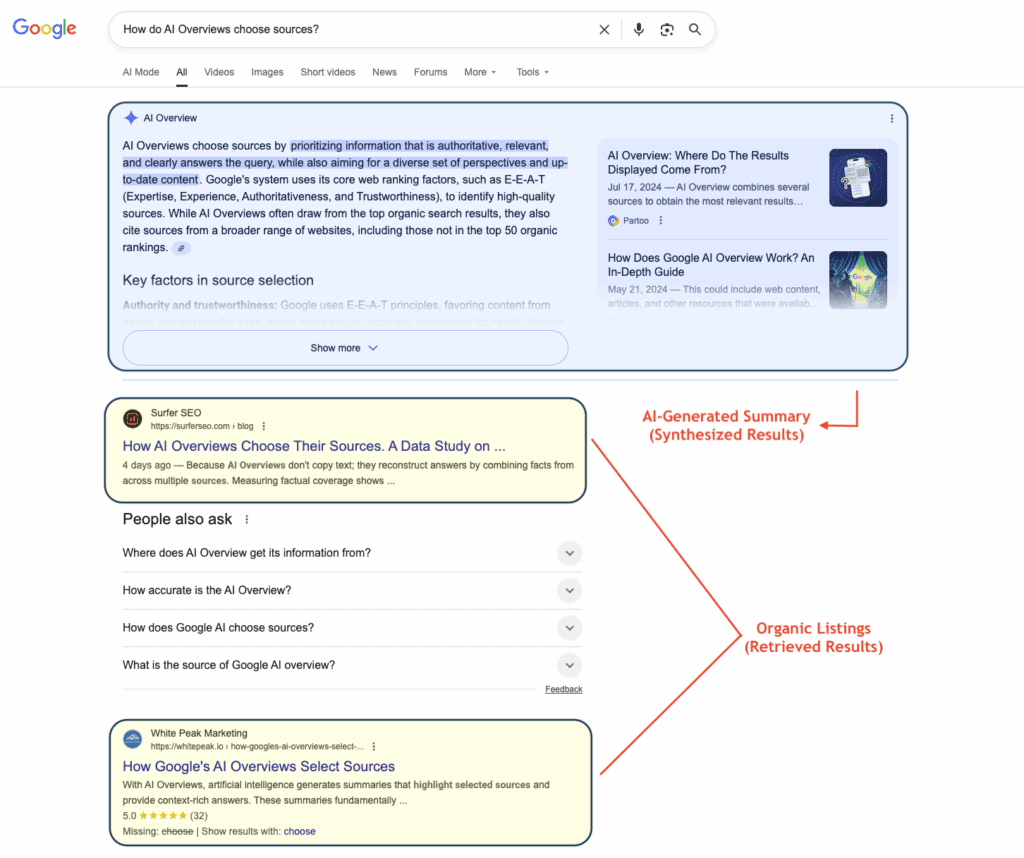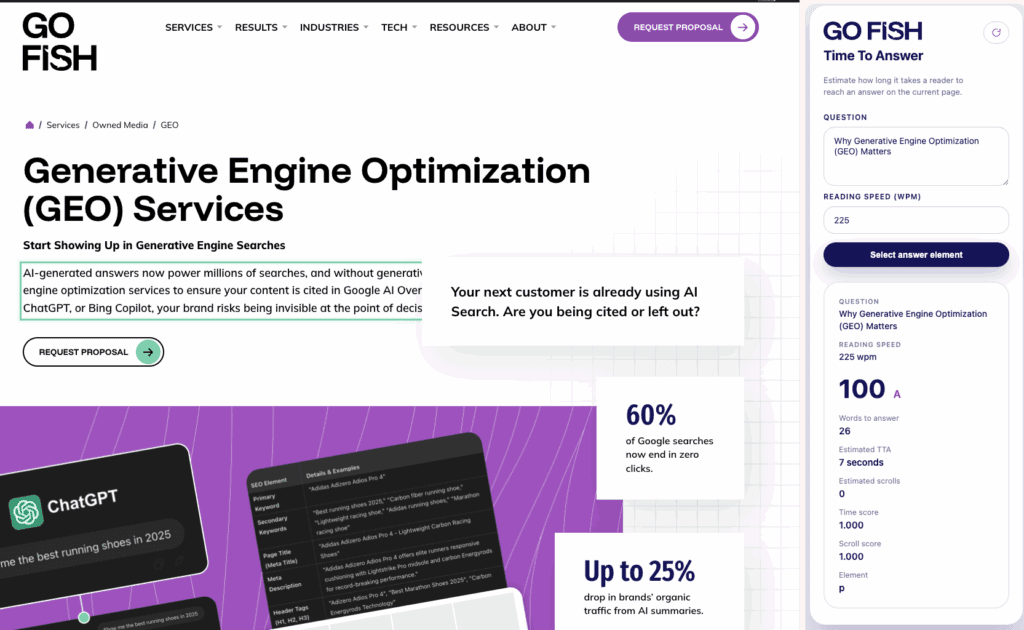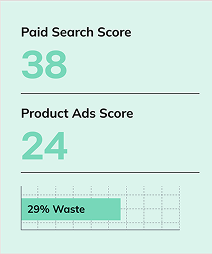Home / Blog / How Generative Engine Optimization Is Shifting from Keywords to Knowledge Capture
AI seo
How Generative Engine Optimization Is Shifting from Keywords to Knowledge Capture
Published: October 20, 2025
Share on LinkedIn Share on Twitter Share on Facebook Click to print Click to copy url

Contents Overview
For years, digital marketing has revolved around keywords. Teams researched what people searched for, mapped those phrases to landing pages or blogs, and optimized to rank higher. It was a clear, repeatable process that built organic visibility and drove traffic.
That process still matters, but the ground beneath it has shifted. Search is changing because users are changing. People no longer stop at results pages. They are now interacting directly with AI systems like Google’s AI Overviews, AI Mode, ChatGPT, and Perplexity. These systems do not return a list of blue links. They create entire answers, combining information from trusted and well-structured sources, often keeping users within the generative environment.
This is where Generative Engine Optimization (GEO) becomes essential. It is not about chasing the next keyword. It is about ensuring your brand’s knowledge is represented accurately inside generative engines. In other words, if SEO helps search engines find your content, GEO helps AI systems understand it.
Key Takeaways
- What is Generative Engine Optimization (GEO)? GEO ensures your brand’s knowledge is understood and reused by AI systems like Google’s AI Overviews, AI Mode, and ChatGPT. It moves beyond keywords to focus on meaning, structure, and factual clarity.
- How does GEO differ from SEO? SEO helps search engines find and rank your content; GEO helps AI systems understand and represent it accurately in generative search engines or search generative experiences (SGE). Visibility now depends on semantic structure, not keyword repetition.
- How can enterprises get started with Generative Engine Optimization (GEO)? Begin with a semantic audit to map Ideal Customer Profiles (ICPs) to their key questions, identify content gaps, and improve factual consistency. Platforms like Barracuda from Go Fish Digital can operationalize this by connecting meaning to performance.
The Search Shift from Retrieval to Generation
Search no longer ends with retrieval. It ends with generation. Traditional search engines identify and rank pages. Generative engines, like Google’s AI Overviews, ChatGPT, and Perplexity, synthesize, reason, and decide which knowledge to reuse. Instead of a ranked list of links, they produce a single answer built from the most contextually aligned, factually consistent sources.
That shift redefines visibility itself. In legacy SEO, the goal was a click. In generative search, the goal is to become part of the answer. When a user asks, “What is a good GEO framework for enterprise brands?”, the model doesn’t scan thousands of pages; it fuses insights from a small subset of high-trust, well-structured sources. Everything else is filtered out.

This is not speculation, it’s measurable:
- On MultiHop-RAG (Tang & Yang, 2024), GPT-4’s factual accuracy rose from 56% → 89% when grounded in curated, context-specific evidence, proving that authoritative retrieval determines generative quality.
- In Summary of a Haystack (Laban et al., 2024), long-context models scored < 20% on citation + coverage metrics without targeted retrieval — a deficit that shrank only when human-validated evidence was supplied.
- Benchmarks like CRAG and ConcurrentQA show that temporal reasoning, multi-source context, and annotation consistency lift joint F1 by 10–30 points over baseline retrieval.
The takeaway: authority is now a data property, not a marketing claim. AI systems elevate content that demonstrates factual grounding, semantic consistency, and verifiable relationships, not keyword repetition.
| Benchmark / Dataset | Focus Area | Measured Impact on Generative Accuracy | Takeaway for Generative Engine Optimization |
|---|---|---|---|
| MultiHop-RAG (Tang & Yang, 2024) | Multi-source evidence retrieval | Factual accuracy improved 56% → 89% with grounded context | Authority and evidence quality directly drive AI citation potential |
| Summary of a Haystack (Laban et al., 2024) | Long-context summarization | Models scored < 20% without targeted retrieval; improved 10–15 pts with validated evidence | Structured, well-linked content boosts factual reuse |
| CRAG / ConcurrentQA (Yang et al., Arora et al., 2023–24) | Temporal and multi-source reasoning | Joint F1 increased 10–30 pts with human annotation and context consistency | Cross-linked and time-aware data increase reliability and inclusion |
| Google AI Overviews (2024 Docs) | Content inclusion criteria | Prioritizes supported information from high-quality, factually consistent sources | Internal consistency and citation support are prerequisites for visibility |
According to Google’s AI Overviews documentation, the inclusion threshold hinges on support: information must be explicitly backed by high-quality sources and internally consistent across an organization’s content graph. In practice, this means your knowledge network (not your keyword list) determines whether your brand is cited, summarized, or ignored.
Generative Engine Optimization (GEO) extends SEO’s foundation of accessibility, authority, and relevance to the generative layer. It ensures AI models can interpret, verify, and reuse your knowledge with confidence, effectively treating your digital ecosystem as structured training data for generative engines.
Why Keywords Are Losing Power
The keyword was once the atomic unit of search. Today, meaning is.
Generative engines and retrieval-augmented LLMs no longer rank pages by exact-match phrases but by semantic coherence: how precisely ideas connect and reinforce one another. Studies on embedding-based retrieval show that language models can identify topical relevance even when fewer than 20% of surface terms overlap between query and source (Karpukhin et al., 2020; Tang & Yang, 2024).
When Google launched the Knowledge Graph, it began indexing relationships between entities (people, organizations, and concepts) rather than isolated keywords. Generative AI extends this principle from indexing to reasoning. It doesn’t just connect “CRM” to “agencies”; it evaluates how those relationships are described, weighted, and supported by evidence.
For example, the query “best CRM software for agencies” is no longer interpreted as a string of words but as a multi-entity relationship:
- CRM → Agency Operations → Productivity Outcomes: Content that explicitly defines and connects these entities, showing causal logic, data support, and relevance, is easier for generative systems to reuse and cite.
Early analyses of Google’s AI Overviews show that pages with structured semantic relationships and comprehensive topical coverage appear up to 40% more often in generated summaries than narrow, keyword-focused pages. While correlation is not causation, the evidence is clear: authority now flows through meaning density, not term density.
For enterprise marketers, this changes the playbook. Visibility is earned not by keyword repetition but by clarity of relationships, how effectively your brand connects the “who,” “what,” and “why” within your domain. Generative Engine Optimization (GEO) transforms this from an SEO tactic into a brand-wide communication strategy.
The Knowledge-First Content Model for Generative Engine Optimization (GEO)
A knowledge-first content model redefines a website as a graph of ideas, not a collection of pages. Each page becomes a data node in a broader knowledge network designed to teach both humans and machines what your brand knows, and how confidently it knows it.
This model prioritizes:
- Conceptual clarity: Each asset answers one definable question or concept, expressed in consistent language.
- Interconnected context: Pages link logically to related ideas, forming a semantic map that mirrors how LLMs retrieve and ground knowledge.
- Factual integrity: Data points, definitions, and sources stay synchronized across channels, minimizing contradiction and reinforcing trust signals.
Over time, this approach compounds into semantic authority: a measurable, machine-readable representation of expertise. In enterprise environments, that authority becomes an asset class: one that improves AI citation rates, strengthens content ROI, and ensures the brand’s perspective is accurately represented in generative summaries.
The result is a durable competitive advantage. Instead of chasing transient ranking opportunities, brands evolve into structured knowledge systems — interpretable, verifiable, and reusable across every generative engine.
For implementation guidance, see Generative Engine Optimization Strategies, which details how to operationalize knowledge-first publishing across large content ecosystems.
Operationalizing the Shift: From Publishing to Training the Model
GEO is not about creating more content. It is about creating the right content, built to teach AI systems how your brand fits into the information landscape. Here are seven principles for putting GEO into action, supported by emerging studies and data.
1. Redefine What Optimization Means
Optimization now means improving clarity, completeness, and factual precision. Studies on retrieval-augmented generation show that models produce more accurate results when trained on well-contextualized, factually dense content.
An optimized GEO page fully covers its topic, connects related concepts, and maintains consistent data and definitions across the site.
2. Build a Knowledge Lifecycle, Not a Content Calendar
A content calendar focuses on publishing frequency. A knowledge lifecycle focuses on accuracy, connectivity, and continuous improvement.
Instead of asking “What are we publishing next?”, GEO teams ask “Is what we’ve published still accurate and aligned with what users and AI systems need to know?”
Industry research, including analysis from the Content Marketing Institute (CMI), demonstrates that updating and expanding existing, contextually rich articles often strengthens brand authority more than producing redundant, new content.
This approach turns your site into a living knowledge base that evolves as your industry and customer questions evolve.
3. Introduce Knowledge-Based Indicators (KBIs)
Organizations measure GEO progress using Knowledge-Based Indicators (KBIs), metrics that assess understanding and usefulness rather than traffic volume.
- Entity Coverage: How many entities and related topics your content defines. Broader coverage correlates with improved comprehension in AI systems.
- Inclusion Frequency: How often your content appears in AI-generated summaries such as Google AI Overviews. Early testing (Search Engine Journal, 2024) suggests factually supported content is referenced more often.
- Semantic Depth: How completely a page explores its subject. Research on AI systems links semantic depth to higher factual reliability in LLM-generated outputs.
- Time to Answer (TTA): How quickly users or AI systems find clear answers. Leading user experience groups like the Nielsen Norman Group affirm that concise, structured content improves both user trust and engagement.
These emerging KPIs help quantify clarity, coverage, and contextual value.

4. Start with ICPs and Map Query Networks
Every Generative Engine Optimization (GEO) strategy begins with understanding the audience. Define your Ideal Customer Profiles (ICPs) and document what each group needs to know at every stage of the buying journey.
From there, apply query fan-out analysis, the process of expanding a single core question into related topics, comparisons, and intent variations. This approach helps uncover how real users explore a subject and what follow-up questions they are likely to ask.
Mapping these networks reveals where your content already meets customer needs and where gaps remain, allowing you to build a knowledge structure that reflects actual search behavior and decision patterns.
5. Integrate GEO Insights into Brand and Performance Strategy
Generative Engine Optimization (GEO) insights inform far more than SEO. They can reshape brand storytelling, campaign planning, and overall positioning.
By analyzing which topics and themes AI systems associate with your brand, you can identify perception gaps and adjust your messaging accordingly. If generative engines recognize your authority in “AI visibility” but overlook your expertise in “marketing automation,” that signals an opportunity to refine and unify how your brand communicates across every channel.
6. Focus on Semantic Context and Consistency
While structured data can help clarify meaning, the stronger differentiator in Generative Engine Optimization (GEO) is semantic consistency, how reliably your brand explains related ideas across all content.
Maintaining consistent terminology, factual framing, and contextual relationships strengthens credibility for both users and AI systems. When your explanations align across pages and channels, generative engines can interpret them as part of one cohesive knowledge narrative.
7. Train Teams to Think in Entities, Not Keywords
The biggest shift is cultural. Writers, strategists, and editors need to plan content around entities, which are clear ideas connected to related concepts, instead of relying on lists of disconnected search phrases.
When teams understand how ideas link together, they naturally produce content that is coherent, contextually rich, and easier for both people and AI systems to interpret. Adopting an entity-first mindset helps the brand maintain consistency and clarity across every piece of communication.
Barracuda enables this approach by mapping content to ICPs, visualizing semantic relationships, and identifying knowledge strengths and gaps. It connects meaning to performance, allowing marketers to improve clarity and precision at scale.
The Enterprise Perspective Shift in Generative Engine Optimization (GEO)
For enterprise brands, this shift represents more than a marketing update: it’s a knowledge-management transformation. Generative Engine Optimization (GEO) provides a scalable framework for clarity: aligning SEO, content, analytics, and brand governance around one outcome: machine interpretability.
In this model, every article, report, or dataset becomes a node in a knowledge system that must be accurate, connected, and retrievable under generative reasoning. When executed well, enterprises can publish less and influence more: each asset strengthens semantic authority, increases inclusion frequency in AI outputs, and reinforces brand alignment across thousands of generated experiences.
The operational implication is profound:
- Marketing teams evolve from publishing content to training models on brand knowledge.
- KPIs expand from traffic and ranking to Knowledge-Based Indicators (KBIs) like entity coverage, inclusion frequency, semantic depth, and time to answer.
- Governance extends beyond tone and messaging to factual consistency and contextual cohesion.
As search becomes conversational and AI-first, clarity becomes the currency of visibility. Brands that invest in factual precision, interconnected ideas, and coherent semantic structures will not only appear in results: they will define them.
FAQs
Common questions and answers from our experts:
1. What is the main difference between SEO and GEO?
SEO helps algorithms find you. GEO helps AI systems understand you.
Search Engine Optimization (SEO) ensures your pages are accessible, crawlable, and relevant for traditional ranking systems. Generative Engine Optimization (GEO) operates a layer higher, ensuring your brand’s knowledge is interpretable, verifiable, and reusable by generative models such as Google’s AI Overviews, AI Mode, and ChatGPT.
In short, SEO drives clicks; Generative Engine Optimization (GEO) drives citations. Success is no longer measured by where you rank, but how often your expertise is referenced inside the answer itself.
2. Do keywords still matter in GEO?
Yes, but only as semantic signals, not scoring tokens.
In Generative Engine Optimization (GEO), keywords guide topical clustering and intent mapping rather than act as ranking levers. Embedding-based retrieval systems evaluate meaning density, not term repetition. This means your keywords should anchor a broader semantic cluster: related entities, supporting facts, and connected explanations.
In practice, Generative Engine Optimization (GEO) uses keywords to train context, not to trigger visibility. The emphasis shifts from keyword coverage to conceptual completeness.
3. How should enterprises begin adopting GEO?
Start with a semantic audit, a structured evaluation of how your content communicates knowledge.
- Map audiences: Define Ideal Customer Profiles (ICPs) and document their recurring questions.
- Expand queries: Use query fan-out analysis to reveal related topics, comparisons, and decision-stage intent.
- Evaluate alignment: Compare that semantic map against existing content to uncover factual gaps and redundancy.
From there, refine pages for clarity, contextual linkage, and definitional consistency rather than keyword density.
4. How does GEO help generate leads?
Generative Engine Optimization (GEO) moves brand discovery upstream, influencing consideration before the click ever occurs.
When generative systems cite your insights within answers, potential buyers encounter your brand as the authoritative source of truth. These impressions drive assisted conversions by building recognition and trust early in the journey.
For enterprise marketers, Generative Engine Optimization (GEO) becomes a demand-generation multiplier: it captures awareness during the question phase and converts it into qualified engagement once users reach your ecosystem.
Conclusion & Next Steps
Generative Engine Optimization (GEO) is not a replacement for SEO, it’s its evolution. It combines the structural precision of traditional optimization with the contextual intelligence of AI. Where SEO ensures your content is found, GEO ensures it is understood, trusted, and reused inside generative systems.
The shift is already underway. AI Overviews, ChatGPT, and Perplexity are redefining visibility from clicks to citations: from ranking pages to representing knowledge. The brands that thrive in this landscape will be those that treat content as data, clarity as currency, and factual precision as the foundation of authority.
Next Steps for Enterprise Teams
- Audit Your Knowledge Graph: Identify inconsistencies, outdated definitions, and disconnected pages that fragment your expertise.
- Map Content to Audience Intelligence: Align every asset with Ideal Customer Profiles (ICPs) and the questions those audiences ask across the buying journey.
- Adopt Knowledge-Based Indicators (KBIs): Track metrics like entity coverage, semantic depth, inclusion frequency, and time to answer to quantify clarity and comprehension.
- Iterate as Models Evolve: Treat your website as a living knowledge system that learns, adapts, and refines its clarity as AI models change.
More on AI search from Go Fish Digital
- How to Find Pages on Your Site That ChatGPT May Be Hallucinating
- OpenAI’s Latest Patents Point Directly to Semantic SEO
- Everything an SEO Should Know About SearchGPT by OpenAI
- How to See When ChatGPT is Quoting Your Content By Analyzing Log Files
- How to Rank in ChatGPT and AI Overviews
- Top Generative Engine Optimization (GEO) Agencies
- What is Generative Engine Optimization (GEO)?
- GEO vs SEO: Differences, Similarities, and More
About Ashish Jacob
MORE TO EXPLORE
Related Insights
More advice and inspiration from our blog
How Home Goods Buyers Decide in 2026 Across Social, Search, AI, and Your Website
How home goods buyers discover, evaluate, and decide in 2026 across...
Kimberly Anderson-Mutch| December 19, 2025
AI Search Is Reshaping How Brands Win in 2026
Learn how AI search is changing SEO in 2026. See what...
Josh Kimble| December 11, 2025
Agentic AI for Search: What Makes Barracuda Different
Barracuda isn’t built to create more content, it’s built to clarify...





